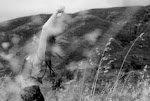 Vitraux on first the first floor of Complejo Cultural de Mayo.
Vitraux on first the first floor of Complejo Cultural de Mayo.
Carlos Gardel and Agustín Magaldi among others showed their art here in the 30’s.
Tango culture takes a while to understand. It has too many codes.
There is one basic step consisting of eight steps but it can be varied to
seven or to six. Somewhere between those steps, come the variations, which
make tango interesting to see. The twists, turns, and figures. Tango is
not meant for feminist women! because it is a dance where men are the
ones that lead. You can add a little something here and there, but
its minimum so basically, you have to follow your lead.
In the dance floor, you dance "rounds", each "round" consists of three
songs. If you go by yourself and someone invites you to dance, you
dance a "round", if you don't want to dance with that person any more
or the person with you, you say "thank you" and return to your table and wait
to be asked out to dance again. It is very rude to not complete a round.
After a round, there is a pause, the music stops - giving people a
chance to get on or off the dance floor. If you continue dancing
with your partner, that interval, is your chance to talk. It can be
very uncomfortable sometimes. You try it and tell me what you feel. It's strange,
you are there with a stranger, you have no clue who he is
and you have a few minutes to talk! The funny part is everyone is so
different and comes from such different backgrounds it's unbelievable.
Quite a mix.
What is interesting, if you have a chance to understand, are the life
stories of the regulars. They really make a big deal out of tango.
You will understand why once you start to manage to dance. You may
dance to waltz rounds and to milonga rounds. Waltz rounds are
slower, the rhythm of milonga is fast, and your partner has to be very
good at it in order to lead you if you are beginning, otherwise don't
attempt it in the dance floor, wait until you are a little more
familiar with it.
Generally, Milongas are simple, the lighting is bad, the music, if
played by a DJ, OK, but it is all of it's ingredients put together
that, once you get a taste of it, make you not want to stop dancing.
If you want to see a Milonga or may be dare to dance, prepare your
clothing and grab your dance shoes because on Jun 29 at 8:30pm you
can hear, see and dance to tango music during 3 hours, in 3 different
dance floors and 3 different DJ's.
The event is called Multimilonga, at will take place in Complejo Cultural de Mayo, Villa Urquiza. It will be a nice chance for you to get immersed in the culture of tango.
Remember also that the Buenos Aires Tango Festival and Dance Championship
begins on August 19, you may not make it this year but... it's always a
good time to start dancing!
post by: Vale Mendez Cañas

































